NEC V230X, V260X, V230, V260, V260W User Manual 2
...
Portable Projector
V300X/V260X/V230X/
V260/V230/V300W/V260W
User’s Manual
The V230X, V230 and V260W are not distributed in North America. Model No.:
NP-V300X, NP-V260X, NP-V230X, NP-V260, NP-V230, NP-V300W, NP-V260W

1st edition, June 2011
•DLP and BrilliantColor are trademarks of Texas Instruments.
•IBM is a trademark or registered trademark of International Business Machines Corporation.
•Macintosh, Mac OS X and PowerBook are trademarks of Apple Inc., registered in the U.S. and other countries.
•Microsoft, Windows, Windows Vista, Internet Explorer, .NET Framework and PowerPoint are either a registered trademark or trademark of Microsoft Corporation in the United States and/or other countries.
•MicroSaver is a registered trademark of Kensington Computer Products Group, a division of ACCO Brands.
•Virtual Remote Tool uses WinI2C/DDC library, © Nicomsoft Ltd.
•HDMI, the HDMI Logo and High-Definition Multimedia Interface are trademarks or registered trademarks of HDMI Licensing LLC.
•NVIDIA is a trademark or registered trademark of NVIDIA Corporation in the United States and/or other countries.
•Blu-ray is a trademark of Blu-ray Disc Association.
•Crestron, Crestron Control, and Crestron RoomView are trademarks or registered trademarks of Crestron Electronics, Inc.
•Other product and company names mentioned in this user’s manual may be the trademarks or registered trademarks of their respective holders.
•TOPPERS Software Licenses
The product includes software licensed under TOPPERS License.
For more information on each software, see “readme.pdf” inside the “about TOPPERS” folder on the supplied CD-ROM.
NOTES
(1)The contents of this user’s manual may not be reprinted in part or whole without permission.
(2)The contents of this user’s manual are subject to change without notice.
(3)Great care has been taken in the preparation of this user’s manual; however, should you notice any questionable points, errors or omissions, please contact us.
(4)Notwithstanding article (3), NEC will not be responsible for any claims on loss of profit or other matters deemed to result from using the Projector.
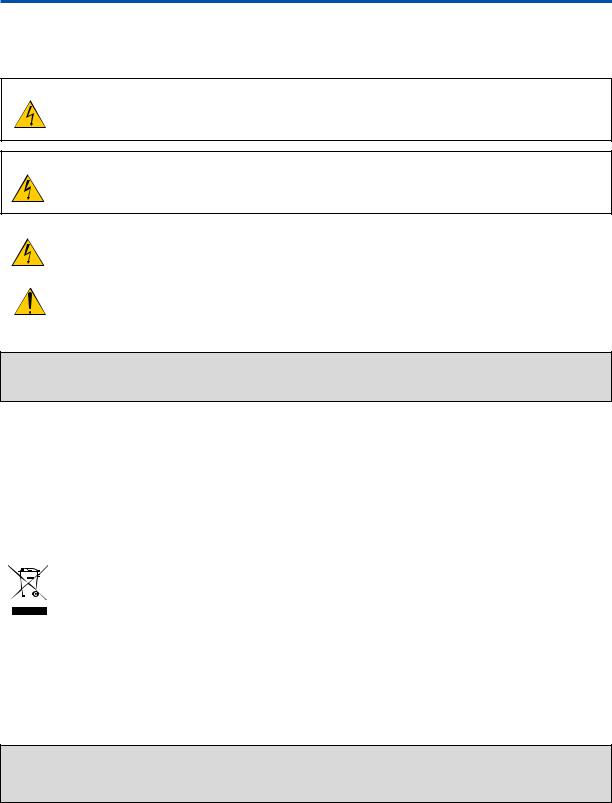
Important Information
Safety Cautions
Precautions
Please read this manual carefully before using your NEC projector and keep the manual handy for future reference.
CAUTION
To turn off main power, be sure to remove the plug from power outlet.
The power outlet socket should be installed as near to the equipment as possible, and should be easily accessible.
CAUTION
TO PREVENT SHOCK, DO NOT OPEN THE CABINET.
THERE ARE HIGH-VOLTAGE COMPONENTS INSIDE.
REFER SERVICING TO QUALIFIED SERVICE PERSONNEL.
This symbol warns the user that uninsulated voltage within the unit may be sufficient to cause electrical shock. Therefore, it is dangerous to make any kind of contact with any part inside of the unit.
This symbol alerts the user that important information concerning the operation and maintenance of this unit has been provided.
The information should be read carefully to avoid problems.
WARNING: TO PREVENT FIRE OR SHOCK, DO NOT EXPOSE THIS UNIT TO RAIN OR MOISTURE.
DO NOT USE THIS UNIT’S PLUG WITH AN EXTENSION CORD OR IN AN OUTLET UNLESS ALL THE PRONGS CAN BE FULLY INSERTED.
DOC Compliance Notice (for Canada only)
This Class B digital apparatus meets all requirements of the Canadian Interference-Causing Equipment Regulations.
Machine Noise Information Regulation - 3. GPSGV,
The highest sound pressure level is less than 70 dB (A) in accordance with EN ISO 7779.
Disposing of your used product
EU-wide legislation as implemented in each Member State requires that used electrical and electronic products carrying the mark (left) must be disposed of separately from normal household waste. This includes projectors and their electrical accessories or lamps. When you dispose of such products, please follow the guidance of your local authority and/or ask the shop where you purchased the product.
After collecting the used products, they are reused and recycled in a proper way. This effort will help us reduce the wastes as well as the negative impact such as mercury contained in a lamp to the human health and the environment at the minimum level.
The mark on the electrical and electronic products only applies to the current European Union Member States.
WARNING TO CALIFORNIA RESIDENTS:
Handling the cables supplied with this product will expose you to lead, a chemical known to the State of California to cause birth defects or other reproductive harm. WASH HANDS AFTER HANDLING.
i

Important Information
RF Interference (for USA only)
WARNING
The Federal Communications Commission does not allow any modifications or changes to the unit EXCEPT those specified by NEC Display Solutions of America, Inc. in this manual. Failure to comply with this government regulation could void your right to operate this equipment. This equipment has been tested and found to comply with the limits for a Class B digital device, pursuant to Part 15 of the FCC Rules. These limits are designed to provide reasonable protection against harmful interference in a residential installation.This equipment generates, uses, and can radiate radio frequency energy and, if not installed and used in accordance with the instructions, may cause harmful interference to radio communications. However, there is no guarantee that interference will not occur in a particular installation.
If this equipment does cause harmful interference to radio or television reception, which can be determined by turning the equipment off and on, the user is encouraged to try to correct the interference by one or more of the following measures:
•Reorient or relocate the receiving antenna.
•Increase the separation between the equipment and receiver.
•Connect the equipment into an outlet on a circuit different from that to which the receiver is connected.
•Consult the dealer or an experienced radio / TV technician for help.
For UK only: In UK, a BS approved power cord with moulded plug has a Black (five Amps) fuse installed for use with this equipment. If a power cord is not supplied with this equipment please contact your supplier.
Important Safeguards
These safety instructions are to ensure the long life of your projector and to prevent fire and shock. Please read them carefully and heed all warnings.
 Installation
Installation
•Do not place the projector in the following conditions:
-on an unstable cart, stand, or table.
-near water, baths, or damp rooms.
-in direct sunlight, near heaters, or heat radiating appliances.
-in a dusty, smoky or steamy environment.
-on a sheet of paper or cloth, rugs or carpets.
•If you wish to have the projector installed on the ceiling:
-Do not attempt to install the projector yourself.
-The projector must be installed by qualified technicians in order to ensure proper operation and reduce the risk of bodily injury.
-In addition, the ceiling must be strong enough to support the projector and the installation must be in accordance with any local building codes.
-Please consult your dealer for more information.
WARNING
•Do not cover the lens with the lens cap or equivalent while the projector is on. Doing so can lead to melting of the cap due to the heat emitted from the light output.
•Do not place any objects, which are easily affected by heat, in front of the projector lens. Doing so could lead to the object melting from the heat that is emitted from the light output.
ii
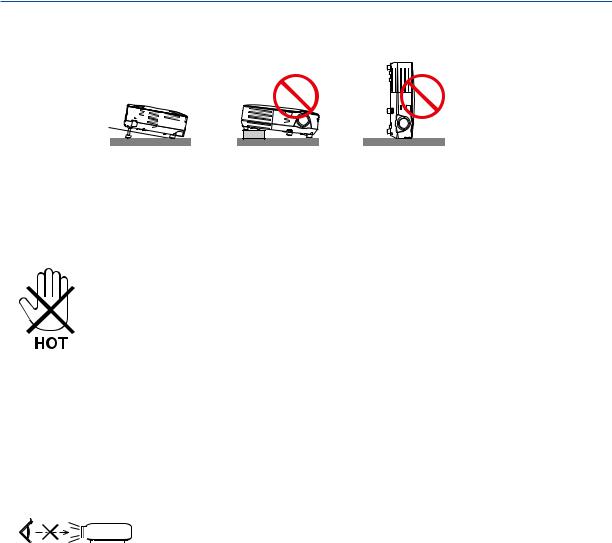
Important Information
Place the projector in a horizontal position
The tilt angle of the projector should not exceed 10 degrees, nor should the projector be installed in any way other than the desktop and ceiling mount, otherwise lamp life could decrease dramatically.
10˚
 Fire and Shock Precautions
Fire and Shock Precautions 
•Ensure that there is sufficient ventilation and that vents are unobstructed to prevent the build-up of heat inside your projector. Allow at least 4 inches (10cm) of space between your projector and a wall.
•Do not try to touch the ventilation outlet on the front side as it can become heated while the projector is turned on and immediately after the projector is turned off.
•Prevent foreign objects such as paper clips and bits of paper from falling into your projector. Do not attempt to retrieve any objects that might fall into your projector. Do not insert any metal objects such as a wire or screwdriver into your projector. If something should fall into your projector, disconnect it immediately and have the object removed by a qualified service personnel.
•Do not place any objects on top of the projector.
•Do not touch the power plug during a thunderstorm. Doing so can cause electrical shock or fire.
•The projector is designed to operate on a power supply of 100-240V AC 50/60 Hz. Ensure that your power supply fits this requirement before attempting to use your projector.
•Do not look into the lens while the projector is on. Serious damage to your eyes could result.
•Keep any items such as magnifying glass out of the light path of the projector. The light being projected from the lens is extensive, therefore any kind of abnormal objects that can redirect light coming out of the lens, can cause unpredictable outcome such as fire or injury to the eyes.
•Do not place any objects, which are easily affected by heat, in front of a projector exhaust vent.
Doing so could lead to the object melting or getting your hands burned from the heat that is emitted from the exhaust.
•Handle the power cord carefully. A damaged or frayed power cord can cause electric shock or fire.
-Do not use any power cords than the supplied one.
-Do not bend or tug the power cord excessively.
-Do not place the power cord under the projector, or any heavy object.
-Do not cover the power cord with other soft materials such as rugs.
-Do not heat the power cord.
-Do not handle the power plug with wet hands.
•Turn off the projector, unplug the power cord and have the projector serviced by a qualified service personnel under the following conditions:
-When the power cord or plug is damaged or frayed.
-If liquid has been spilled into the projector, or if it has been exposed to rain or water.
iii

Important Information
-If the projector does not operate normally when you follow the instructions described in this user's manual.
-If the projector has been dropped or the cabinet has been damaged.
-If the projector exhibits a distinct change in performance, indicating a need for service.
•Disconnect the power cord and any other cables before carrying the projector.
•Turn off the projector and unplug the power cord before cleaning the cabinet or replacing the lamp.
•Turn off the projector and unplug the power cord if the projector is not to be used for an extended period of time.
•When using a LAN cable (V300X/V260X/V300W/V260W only):
For safety, do not connect to the connector for peripheral device wiring that might have excessive voltage.
CAUTION
•Do not use the tilt-foot for purposes other than originally intended. Misuses such as using the tilt foot to carry or hang (from the wall or ceiling) the projector can cause damage to the projector.
•Do not send the projector in the soft case by parcel delivery service or cargo shipment. The projector inside the soft case could be damaged.
•Select [HIGH] in Fan mode if you continue to use the projector for consecutive days. (From the menu, select [SETUP] → [OPTIONS(1)] → [FAN MODE] → [HIGH].)
•Do not turn off the AC power for 60 seconds after the lamp is turned on and while the POWER indicator is blinking green.
Doing so could cause premature lamp failure.
•Parts of the projector may become temporarily heated if the projector is turned off with the POWER button or if the AC power supply is disconnected during normal projector operation.
Use caution when picking up the projector.
 Remote Control Precautions
Remote Control Precautions
•Handle the remote control carefully.
•If the remote control gets wet, wipe it dry immediately.
•Avoid excessive heat and humidity.
•Do not heat, take apart, or throw batteries into fire.
•If you will not be using the remote control for a long time, remove the batteries.
•Ensure that you have the batteries' polarity (+/–) aligned correctly.
•Do not use new and old batteries together, or use different types of batteries together.
•Dispose of used batteries according to your local regulations.
Lamp Replacement
•Use the specified lamp for safety and performance.
•To replace the lamp, follow all instructions provided on page 81.
•Be sure to replace the lamp when the message [THE LAMP HAS REACHED THE END OF ITS USABLE LIFE. PLEASE REPLACE THE LAMP. USE THE SPECIFIED LAMP FOR SAFETY AND PERFORMANCE] appears. If you continue to use the lamp after the lamp has reached the end of its usable life, the lamp bulb may shatter, and pieces of glass may be scattered in the lamp case. Do not touch them as the pieces of glass may cause injury.
If this happens, contact your dealer for lamp replacement.
A Lamp Characteristic
The projector has a high-pressure mercury lamp as a light source.
A lamp has a characteristic that its brightness gradually decreases with age. Also repeatedly turning the lamp on and off will increase the possibility of its lower brightness.
iv

Important Information
 CAUTION:
CAUTION:
•DO NOT TOUCH THE LAMP immediately after it has been used. It will be extremely hot. Turn the projector off and then disconnect the power cord. Allow at least one hour for the lamp to cool before handling.
•When removing the lamp from a ceiling-mounted projector, make sure that no one is under the projector. Glass fragments could fall if the lamp has been burned out.
Note for US Residents
The lamp in this product contains mercury. Please dispose according to Local, State or Federal Laws.
 Health precautions to users viewing 3D images
Health precautions to users viewing 3D images
Before viewing, be sure to read health care precautions that may be found in the user’s manual included with your LCD shutter eyeglasses or your 3D compatible content such as DVDs, video games, computer's video files and the like.
To avoid any adverse symptoms, heed the following:
-Do not use LCD shutter eyeglasses for viewing any material other than 3D images.
-Allow a distance of 2 m/7 feet or greater between the screen and a user. Viewing 3D images from too close a distance can strain your eyes.
-Avoid viewing 3D images for a prolonged period of time. Take a break of 15 minutes or longer after every hour of viewing.
-If you or any member of your family has a history of light-sensitive seizures, consult a doctor before viewing 3D images.
-While viewing 3D images, if you get sick such as nausea, dizziness, queasiness, headache, eyestrain, blurry vision, convulsions, and numbness, stop viewing them. If symptoms still persist, consult a doctor.
-View 3D images from the front of the screen. Viewing from an angle may cause fatigue or eyestrain.
About High Altitude mode
•If you use the projector at altitudes approximately 5500 feet/1700 meters (3000 feet/900 meters on V300X/V300W) or higher, you are recommended to set [FAN MODE] to [HIGH ALTITUDE]. Failure to do so may cause the projector to overheat , resulting in malfunction. (→ page 70)
•Using the projector at high altitudes or in low air pressure can shorten the life of components.
About Copyright of original projected pictures:
Please note that using this projector for the purpose of commercial gain or the attraction of public attention in a venue such as a coffee shop or hotel and employing compression or expansion of the screen image with the following functions may raise concern about the infringement of copyrights which are protected by copyright law.
[ASPECT RATIO], [KEYSTONE], Magnifying feature and other similar features.
This device is not intended for use in the direct field of view at visual display workplaces.To avoid incommoding reflections at visual display workplaces this device must not be placed in the direct field of view.
v

Table of Contents
Important Information............................................................................................ |
i |
1. Introduction........................................................................................................... |
1 |
1 What’s in the Box?.......................................................................................................... |
1 |
Introduction to the Projector........................................................................................... |
2 |
Congratulations on Your Purchase of the Projector.................................................. |
2 |
Features you'll enjoy:................................................................................................ |
2 |
About this user's manual.......................................................................................... |
3 |
Part Names of the Projector........................................................................................... |
4 |
Front/Top................................................................................................................... |
4 |
Rear.......................................................................................................................... |
4 |
Top Features............................................................................................................. |
5 |
Terminal Panel Features........................................................................................... |
6 |
Part Names of the Remote Control................................................................................ |
7 |
Battery Installation.................................................................................................... |
8 |
Remote Control Precautions.................................................................................... |
8 |
Operating Range for Wireless Remote Control........................................................ |
8 |
2. Installation and Connections...................................................................... |
9 |
Setting Up the Screen and the Projector........................................................................ |
9 |
Selecting a Location [V300X/V260X/V230X/V260/V230]......................................... |
9 |
Selecting a Location [V300W/V260W].................................................................... |
10 |
Throw Distance and Screen Size........................................................................... |
11 |
Making Connections..................................................................................................... |
13 |
Connecting Your PC or Macintosh Computer......................................................... |
13 |
Connecting an External Monitor............................................................................. |
14 |
Connecting Your DVD Player with Component Output........................................... |
15 |
Connecting Your VCR............................................................................................. |
16 |
Connecting HDMI Input (V300X/V260X/V300W/V260W only)............................... |
17 |
Connecting to a Network (V300X/V260X/V300W/V260W only)............................. |
18 |
Connecting the Supplied Power Cord..................................................................... |
19 |
3. Projecting an Image (Basic Operation)............................................... |
20 |
Turning on the Projector............................................................................................... |
20 |
Note on Startup screen (Menu Language Select screen)...................................... |
21 |
Selecting a Source....................................................................................................... |
22 |
Selecting the computer or video source................................................................. |
22 |
Adjusting the Picture Size and Position........................................................................ |
23 |
Adjust the Tilt Foot.................................................................................................. |
24 |
Zoom...................................................................................................................... |
25 |
Focus...................................................................................................................... |
25 |
Correcting Keystone Distortion.................................................................................... |
26 |
Correcting Keystone Distortion............................................................................... |
26 |
Adjusting with buttons on the cabinet..................................................................... |
26 |
Adjusting with the remote control........................................................................... |
27 |
Optimizing Computer Signal Automatically.................................................................. |
28 |
Adjusting the Image Using Auto Adjust.................................................................. |
28 |
vi

Table of Contents |
|
Turning Up or Down Volume......................................................................................... |
28 |
7 Turning off the Projector............................................................................................... |
29 |
After Use...................................................................................................................... |
30 |
4. Convenient Features...................................................................................... |
31 |
1 Turning off the Image and Sound................................................................................. |
31 |
2 Freezing a Picture........................................................................................................ |
31 |
Enlarging a Picture....................................................................................................... |
31 |
Changing Eco Mode..................................................................................................... |
32 |
5 Checking Energy-Saving Effect [CARBON METER].................................................... |
33 |
6 Preventing the Unauthorized Use of the Projector [SECURITY].................................. |
34 |
7 Using the Optional Remote Mouse Receiver (NP01MR)............................................. |
37 |
8 Using the Computer Cable (VGA) to Operate the Projector (Virtual Remote Tool)...... |
39 |
9 Network Setting by Using an HTTP Browser (V300X/V260X/V300W/V260W only).... |
45 |
J Viewing 3D Images...................................................................................................... |
48 |
5. Using On-Screen Menu................................................................................ |
52 |
Using the Menus.......................................................................................................... |
52 |
2 Menu Elements............................................................................................................ |
53 |
3 List of Menu Items........................................................................................................ |
54 |
4 Menu Descriptions & Functions [SOURCE]................................................................. |
56 |
5 Menu Descriptions & Functions [ADJUST].................................................................. |
57 |
6 Menu Descriptions & Functions [SETUP].................................................................... |
64 |
7 Menu Descriptions & Functions [INFO.]....................................................................... |
77 |
8 Menu Descriptions & Functions [RESET].................................................................... |
79 |
6. Maintenance....................................................................................................... |
80 |
Cleaning the Cabinet and the Lens.............................................................................. |
80 |
Replacing the Lamp..................................................................................................... |
81 |
7. Appendix............................................................................................................... |
84 |
Troubleshooting............................................................................................................ |
84 |
Indicator Messages................................................................................................ |
84 |
Specifications............................................................................................................... |
87 |
Cabinet Dimensions..................................................................................................... |
91 |
Pin Assignments of D-Sub COMPUTER Input Connector........................................... |
92 |
Mini D-Sub 15 Pin Connector................................................................................. |
92 |
Compatible Input Signal List........................................................................................ |
93 |
PC Control Codes and Cable Connection.................................................................... |
94 |
PC Control Codes................................................................................................... |
94 |
Cable Connection................................................................................................... |
94 |
PC Control Connector (D-SUB 9P)........................................................................ |
94 |
Troubleshooting Check List.......................................................................................... |
95 |
8 TravelCare Guide.......................................................................................................... |
97 |
9 TCO Certification.......................................................................................................... |
97 |
vii
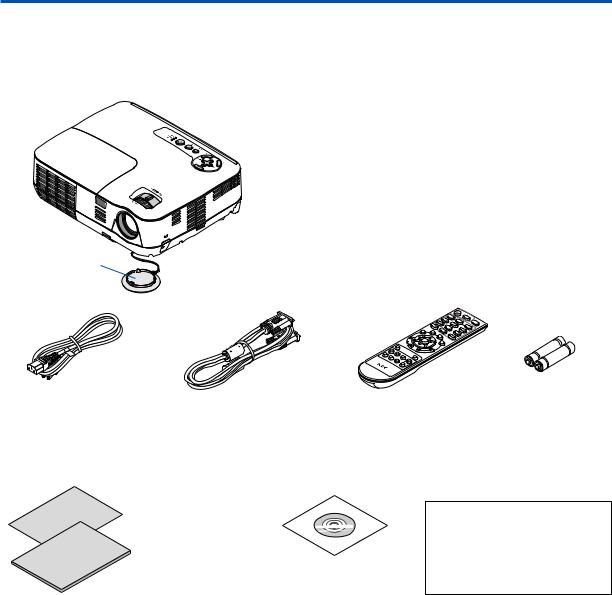
1. Introduction
1 What’s in the Box?
Make sure your box contains everything listed. If any pieces are missing, contact your dealer. Please save the original box and packing materials if you ever need to ship your projector.
Projector
Lens cap
(24F45801)
Power cord |
Computer cable (VGA) |
Remote control |
Batteries (AAAx2) |
(US: 7N080236) |
(7N520073) |
(7N900923) |
|
(EU: 7N080022) |
|
|
|
(Brazil: 7N080520) |
|
|
|
For North America |
NEC Projector CD-ROM |
Quick Setup Guide (7N8N1921) |
User’s manual |
Important Information (7N8N1901) |
(7N951641) |
For other countries than North |
|
America |
|
Quick Setup Guide (7N8N1921) and |
|
(7N8N1931) |
|
Important Information (7N8N1901) |
|
and (7N8N1911) |
|
For North America only
Registration card
Limited warranty
For customers in Europe:
You will find our current valid Guarantee Policy on our Web Site: www.nec-display-solutions.com
1

1. Introduction
Introduction to the Projector
This section introduces you to your new projector and describes the features and controls.
Congratulations on Your Purchase of the Projector
This DLP® projector is one of the very best projectors available today. The projector enables you to project precise images up to 300 inches (measured diagonally) from your PC or Macintosh computer (desktop or notebook), VCR, DVD player or document camera.
You can use the projector on a tabletop or cart, you can use the projector to project images from behind the screen, and the projector can be permanently mounted on a ceiling*1. The remote control can be used wirelessly.
*1 Do not attempt to mount the projector on a ceiling yourself.
The projector must be installed by qualified technicians in order to ensure proper operation and reduce the risk of bodily injury.
In addition, the ceiling must be strong enough to support the projector and the installation must be in accordance with any local building codes. Please consult your dealer for more information.
Features you'll enjoy:
•Quick start & Quick Power Off
7 seconds after turning on the power, the projector is ready to display PC or video images.
The projector can be put away immediately after the projector is powered down. No cool down period is required after the projector is turned off from the remote control or cabinet control panel.
•Direct Power Off
The projector has a feature called “Direct Power Off”. This feature allows the projector to be turned off (even when projecting an image) by disconnecting the AC power supply.
To turn off the AC power supply when the projector is powered on, use a power strip equipped with a switch and a breaker.
•Less than 1W in standby condition with energy saving technology
Selecting [POWER-SAVING] for [STANDBY MODE] from the menu can put the projector in power-saving mode that consumes only 0.49W (100-130V AC)/0.71W (200-240V AC).
•Carbon Meter
This feature will show energy-saving effect in terms of CO2 emission reduction (kg) and electricity cost when the projector’s [ECO MODE] is set to [ON].
The amount of CO2 emission reduction will be displayed in the confirmation message at the time of power-off and in the INFO of the on-screen menu.
•7W built-in speaker for an integrated audio solution
Powerful 7 watt speaker provides volume need for large rooms.
•HDMI input port provides digital signal (V300X/V260X/V300W/V260W only)
The HDMI input provides HDCP compatible digital signals. The HDMI input also supports audio signal.
•Two computer inputs provided (V300X/V260X/V300W/V260W only)
The V300X/V260X/V300W/V260W projector comes with two computer input ports (Mini D-Sub15P) with audio inputs (two stereo mini jacks) as well as composite and S-video inputs with audio inputs (a pair of L/R RCA jacks).
•DLP® projector with high resolution and high brightness
High resolution display - up to UXGA compatible, XGA (V300X/V260X/V230X)/ SVGA (V260/V230)/ WXGA(V300W/ V260W) native resolution.
2

1. Introduction
•AUTO POWER ON and AUTO POWER OFF features
The DIRECT POWER ON, AUTO POWER ON(COMP.), AUTO POWER OFF, and OFF TIMER features eliminate the need to always use the POWER button on the remote control or projector cabinet.
•Preventing unauthorized use of the projector
Enhanced smart security settings for keyword protection, cabinet control panel lock, security slot, chain opening to help prevent unauthorized access, adjustments and theft deterrence.
•The supplied remote control allows you to assign a CONTROL ID to the projector
Multiple projectors can be operated separately and independently with the same single remote control by assigning an ID number to each projector.
•Integrated RJ-45 connector for wired networking capacity (V300X/V260X/V300W/V260W only)
An RJ-45 connector is equipped as standard feature.
•3D images supported
The projector provides 3D images to a user wearing commercially available DLP® Link compatible LCD shutter eyeglasses.
•NVIDIA® 3D Vision supported (V300X/V300W only)
The projector is certified as a display device for NVIDIA® 3D VisionTM, which allows you to view 3D images by using with supported graphics board or software.
•Crestron RoomView® supported (V300X/V260X/V300W/V260W)
The projector suppors Crestron RoomView which allows you to control and manage equipment connected to your network from your computer.
About this user's manual
The fastest way to get started is to take your time and do everything right the first time. Take a few minutes now to review the user's manual. This may save you time later on. At the beginning of each section of the manual you'll find an overview. If the section doesn't apply, you can skip it.
In this user's manual the drawings of the projector show an example of V300X.
3
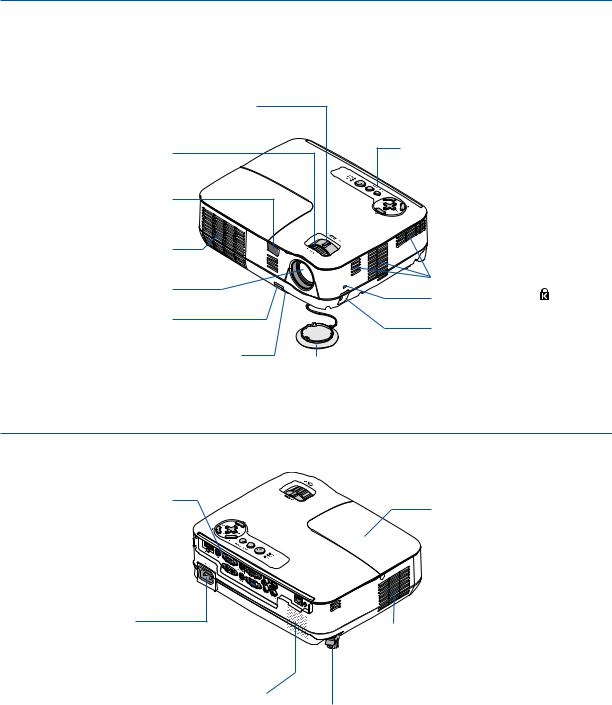
1. Introduction
Part Names of the Projector
Front/Top
Zoom Lever |
|
|
|
(→ page 25) |
|
|
|
Focus Ring |
|
Controls |
|
|
(→ page 5) |
||
(→ page 25) |
|
||
|
|
||
Remote Sensor |
|
|
|
(→ page 8) |
|
|
|
Ventilation (outlet) |
|
|
|
Heated air is ex- |
|
|
|
hausted from here. |
|
Ventilation (inlet) |
|
Lens |
|
||
|
Built-in Security Slot ( )* |
||
|
|
||
Adjustable Tilt Foot Lever |
|
Security chain opening |
|
(→ page 24) |
|
||
|
Attach an anti-theft device. |
||
|
|
||
Adjustable Tilt Foot |
Lens Cap |
The security chain opening accepts |
|
(→ page 24) |
security wires or chains up to 0.18 |
||
|
inch/4.6 mm in diameter.
*This security slot supports the MicroSaver ® Security System.
Rear
Terminal Panel
(→ page 6)
AC Input
Connect the supplied power cord's three-pin plug here, and plug the other end into an active wall outlet. (→ page 19)
Monaural Speaker (7W)
Lamp Cover
(→ page 82)
 Ventilation (inlet)
Ventilation (inlet)
 Spacer (black rubber)
Spacer (black rubber)
To fine-adjust the height of the rear foot, remove the spacer and rotate
the rear foot to the desired height.
Rear Foot
(→ page 24)
4

1. Introduction
Top Features
7 |
8 |
9 |
10 |
5 |
6 |
1 |
2 |
3 |
4 |
1.POWER Button (ON / STAND BY) ( ) (→ page 20, 29)
) (→ page 20, 29)
2.POWER Indicator (→ page 19, 20, 29, 84)
3.STATUS Indicator (→ page 84)
4.LAMP Indicator (→ page 81, 84)
5.AUTO ADJ. Button (→ page 28)
6.SOURCE Button (→ page 22)
7.MENU Button (→ page 52)
8./ Keystone / Volume Buttons
(→ page 26, 28, 31)
9.ENTER Button
10.EXIT Button
5
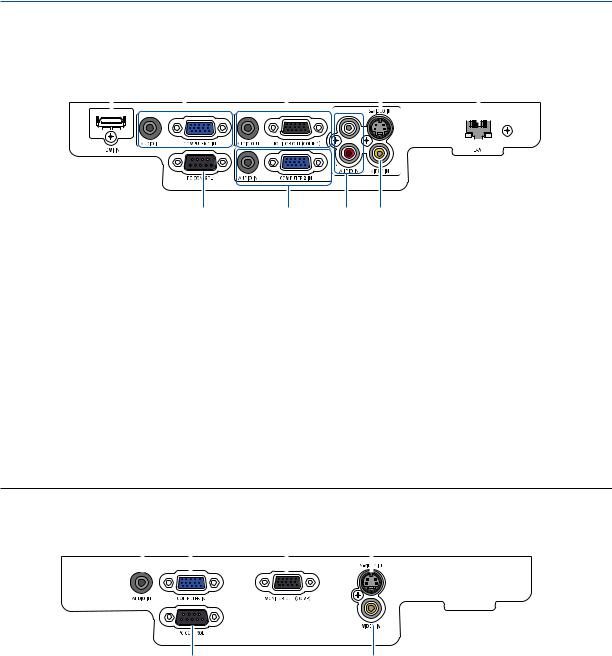
1. Introduction
Terminal Panel Features
V300X/V260X/V300W/V260W
9 |
|
1 |
3 |
5 |
8 |
|
||||||||||||
|
|
|
|
|
|
|
|
|
|
|
|
|
|
|
|
|
|
|
|
|
|
|
|
|
|
|
|
|
|
|
|
|
|
|
|
|
|
|
|
|
|
|
|
|
|
|
|
|
|
|
|
|
|
|
|
|
|
|
|
|
|
|
|
|
|
|
|
|
|
|
|
|
|
|
|
|
|
|
|
|
|
|
|
|
|
|
|
|
|
|
|
|
|
|
|
|
|
|
|
|
|
|
|
|
|
|
|
|
|
|
|
|
|
|
|
|
|
|
|
|
|
|
|
|
|
|
|
|
|
|
|
|
4 |
2 |
7 |
6 |
1.COMPUTER 1 IN/ Component Input Connector (Mini D-Sub 15 Pin) (→ page 13, 14, 15)
AUDIO IN Mini Jack (Stereo Mini) (→ page 13, 14, 15)
2.COMPUTER 2 IN/ Component Input Connector (Mini D-Sub 15 Pin) (→ page 13, 14, 15)
AUDIO IN Mini Jack (Stereo Mini) (→ page 13, 14, 15)
3.MONITOR OUT (COMP 1) Connector (Mini D-Sub 15 Pin) (→ page 14)
AUDIO OUT Mini Jack (Stereo Mini) (→ page 14)
4.PC CONTROL Port (D-Sub 9 Pin) (→ page 94) Use this port to connect a PC or control system. This enables you to control the projector using serial communication protocol. If you are writing your own program, typical PC control codes are on page 94.
5.S-VIDEO IN Connector (Mini DIN 4 Pin)
(→ page 16)
6.VIDEO IN Connector (RCA) (→ page 16)
7.VIDEO/S-VIDEO AUDIO Input Jacks L/R (RCA)
(→ page 16)
8.LAN Port (RJ-45) (→ page 18)
9.HDMI Connector (→ page 13, 17)
V230X/V260/V230
5 |
2 |
1 |
4 |
|||||
|
|
|
|
|
|
|
|
|
|
|
|
|
|
|
|
|
|
|
|
|
|
|
|
|
|
|
6 |
3 |
1.MONITOR OUT Connector (Mini D-Sub 15 Pin) (→ page 14)
2.COMPUTER IN/ Component Input Connector (Mini D-Sub 15 Pin) (→ page 13, 14, 15)
3.VIDEO IN Connector (RCA) (→ page 16)
4.S-VIDEO IN Connector (Mini DIN 4 Pin)
(→ page 16)
5.AUDIO IN Mini Jack (Stereo Mini)
(→ page 13, 14, 15, 16)
6.PC CONTROL Port (D-Sub 9 Pin) (→ page 94) Use this port to connect a PC or control system. This enables you to control the projector using serial communication protocol. If you are writing your own program, typical PC control codes are on page 94.
6
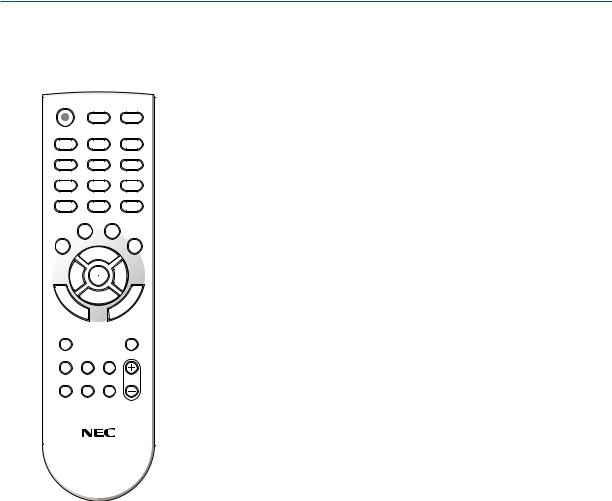
1. Introduction
Part Names of the Remote Control
1 |
3 |
|
2 |
7 |
|
5 |
||
4 |
6 |
|
8 |
10 |
|
9 |
15 |
|
11 |
13 |
|
14 |
12 |
|
17 |
16 |
|
18 |
19 |
|
21 |
20 |
|
25 |
||
22 |
||
27 |
||
|
||
23 |
24 |
|
28 |
||
26 |
||
29 |
||
|
||
32 |
30 |
|
|
31 |
|
1. Infrared Transmitter |
|
|
(→ page 8) |
|
2.POWER ON Button
(→ page 20)
3.POWER OFF Button
(→ page 29)
4, 5, 6. COMPUTER 1/2/3 Button
(→ page 22)
(COMPUTER3 is not available on all the projector models. COMPUTER2 is not available on V230X/ V260/V230.)
7.AUTO ADJ. Button
(→ page 28)
8.VIDEO Button
(→ page 22)
9.S-VIDEO Button
(→ page 22)
10.HDMI Button
(→ page 22)
11.VIEWER Button
(not available on this series of projectors)
12.NETWORK Button
(not available on this series of projectors)
13.USB DISPLAY Button
(not available on this series of projectors)
14.ID SET Button
(→ page 69)
15.Numeric Keypad Button/CLEAR Button
(→ page 69)
16.FREEZE Button
(→ page 31)
17.AV-MUTE Button
(→ page 31)
18.MENU Button
(→ page 52)
19.EXIT Button (→ page 52)
20.Button (→ page 38, 52)
21.ENTER Button (→ page 52)
22.D-ZOOM (+)(–) Button
(→ page 31)
23.MOUSE L-CLICK Button*
(→ page 38)
24.MOUSE R-CLICK Button*
(→ page 38)
25.PAGE / Button*
(→ page 37, 38)
26.ECO Button (→ page 32)
27.KEYSTONE Button
(→ page 27)
28.PICTURE Button
(→ page 57, 58)
29.VOL. (+)(–) Button
(→ page 28)
30.ASPECT Button
(→ page 61)
31.FOCUS/ZOOM Button
(not available on this series of projectors)
32.HELP Button
(→ page 77)
*The PAGE g/h, MOUSE L-CLICK and MOUSE R-CLICK buttons work only when the optional remote mouse receiver (NP01MR) is connected with your computer.
7
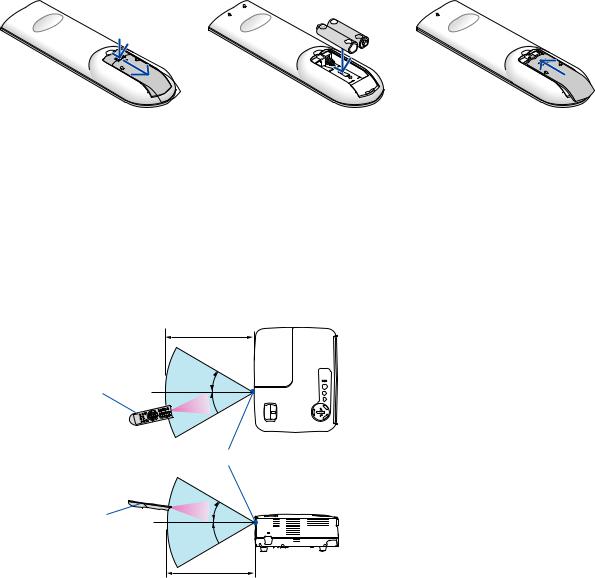
|
|
1. Introduction |
Battery Installation |
|
|
1 Press firmly and slide the battery |
2 Install new batteries (AAA). Ensure |
3 Slip the cover back over the bat- |
cover off. |
that you have the batteries’ polarity |
teries until it snaps into place. Do |
|
(+/−) aligned correctly. |
not mix different types of batteries |
|
|
or new and old batteries. |
Remote Control Precautions
•Handle the remote control carefully.
•If the remote control gets wet, wipe it dry immediately.
•Avoid excessive heat and humidity.
•Do not heat, take apart, or throw batteries into fire.
•If you will not be using the remote control for a long time, remove the batteries.
•Ensure that you have the batteries’ polarity (+/−) aligned correctly.
•Do not use new and old batteries together, or use different types of batteries together.
•Dispose of used batteries according to your local regulations.
Operating Range for Wireless Remote Control
7 m/22 feet
Remote control |
30° |
|
|
|
30° |
Remote sensor on projector cabinet
Remote control |
30° |
30° 
7 m/22 feet
•The infrared signal operates by line-of-sight up to a distance of about 22 feet/7 m and within a 60-degree angle of the remote sensor on the projector cabinet.
•The projector will not respond if there are objects between the remote control and the sensor, or if strong light falls on the sensor. Weak batteries will also prevent the remote control from properly operating the projector.
8
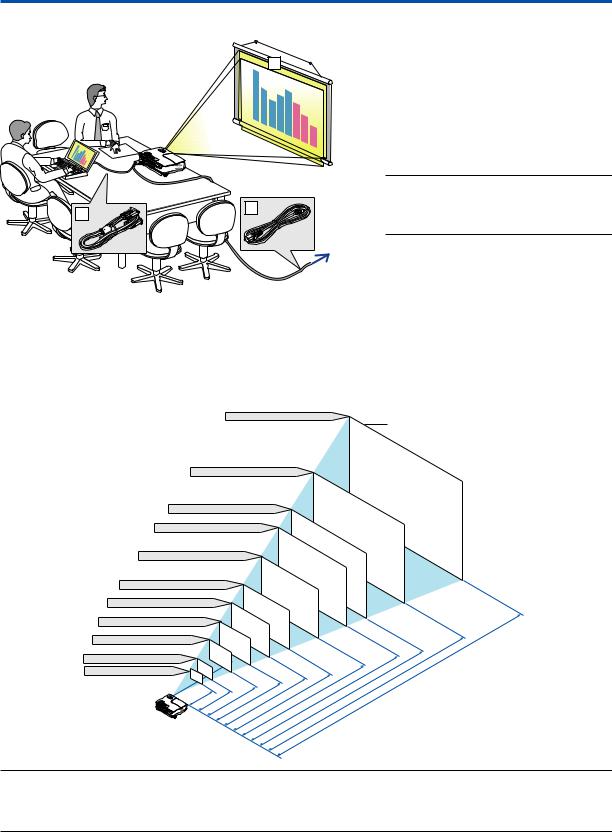
2. Installation and Connections
This section describes how to set up your projector and how to connect video and audio sources. Your projector is simple to set up and use. But before you get started, you must first:
1 |
Set up a screen and the projector. |
|
Connect your computer or video equip- |
|
ment to the projector. See pages 13, 14, |
|
15, 16, 17, 18. |
|
Connect the supplied power cord. See |
|
page 19. |
|
NOTE: Ensure that the power cord and any other |
|
cables are disconnected before moving the projec- |
|
tor. When moving the projector or when it is not |
|
in use, cover the lens with the lens cap. |
To the wall outlet.
Setting Up the Screen and the Projector
Selecting a Location [V300X/V260X/V230X/V260/V230]
The further your projector is from the screen or wall, the larger the image. The minimum size the image can be is 30" (0.76 m) measured diagonally when the projector is roughly 49 inches (1.3 m) from the wall or screen. The largest the image can be is 300" (7.6 m) when the projector is about 493 inches (12.5 m) from the wall or screen. Use the chart below as a rough guide.
300"
Screen Size (diagonal: inch)
487.7(W) x 365.8(H) / 192(W) x 144(H)
240"
406.4(W) x 304.8(H) / 160(W) x 120(H)
365.8(W) x 274.3(H) / 144(W) x 108(H)
200" 180"
304.8(W) x 228.6(H) / 120(W) x 90(H)
150"
243.8(W) x 182.9(H) / 96(W) x 72(H) |
120" |
||
203.2(W) x 152.4(H) / 80(W) x 60(H) |
|
||
|
100" |
||
162.6(W) x 121.9(H) / 64(W) x 48(H) |
|
||
80" |
|||
121.9(W) x 91.4(H) / 48(W) x 36(H) |
|||
60" |
|
||
81.3(W) x 61.0(H) / 32(W) x 24(H) |
|
||
|
|
||
61.0(W) x 45.7(H) / 24(W) x 18(H)
Lens center 
|
|
|
|
|
|
.5" |
m/inch) |
.3/246" |
.3m/328" |
.0m/394" |
.5m/492 |
||||
12 |
|
|
|||||
|
.5" |
|
|
|
|
|
|
75m/295 |
10 |
|
|
(Unit: |
|||
6 . |
8 |
|
|
||||
Distance |
|
||||||
|
|
|
|
|
|||
NOTE:
•The distances are indicated by intermediate values between tele and wide. Use as a rule of thumb.
•The Zoom lever adjusts the image size up to +/-5%
•For more details on throw distance, see page 11.
9
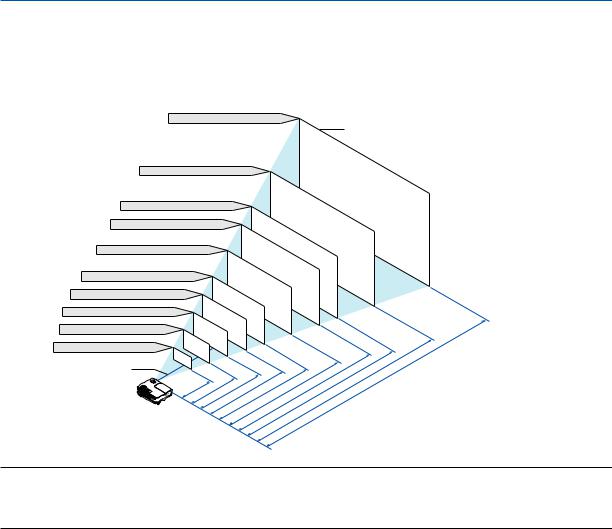
2. Installation and Connections
Selecting a Location [V300W/V260W]
The further your projector is from the screen or wall, the larger the image. The minimum size the image can be is 30" (0.76 m) measured diagonally when the projector is roughly 41 inches (1.0 m) from the wall or screen. The largest the image can be is 300" (7.6 m) when the projector is about 413 inches (10.5 m) from the wall or screen. Use the chart below as a rough guide.
Screen Size (Unit: cm/inch)
646.2(W) X 403.9(H)/254(W) X 159(H)
300"
516.9(W) X 323.1(H)/204(W) X 127(H)
240"
Screen Size (diagonal: inch)
430.8(W) X 269.2(H)/170(W) X 106(H) |
|
200" |
|
|
|
|
|
|
|
|||
387.7(W) X 242.3(H)/153(W) X 95(H) |
|
|
|
|
|
|
|
|
||||
323.1(W) X 201.9(H)/127(W) X 79(H) |
|
180" |
|
|
|
|
|
|
|
|||
|
150" |
|
|
|
|
|
|
|
|
|||
258.5(W) X 161.5(H)/102(W) X 64(H) |
|
|
|
|
|
|
|
|
|
|
||
|
120" |
|
|
|
|
|
|
|
|
|||
215.4(W) X 134.6(H)/85(W) X 53(H) |
|
|
|
|
|
|
|
|
|
|
||
|
100" |
|
|
|
|
|
|
|
|
|
||
172.3(W) X 107.7(H)/68(W) X 42(H) |
|
|
|
|
|
|
|
|
|
|
||
129.2(W) X 80.8(H)/51(W) X 32(H) |
|
80" |
|
|
|
|
|
|
|
|
|
|
60" |
|
|
|
|
|
|
|
|
|
|
||
86.2(W) X 53.8(H)/34(W) X 21(H) |
|
|
|
|
|
|
|
|
|
|
||
40" |
|
|
|
|
|
|
|
|
|
|
|
|
Lens center |
|
|
|
|
|
|
|
|
|
|
|
|
|
|
|
|
|
|
|
|
|
|
|
|
|
|
. |
|
. |
.2” |
.0” |
. |
|
. |
.0” |
.6” |
||
|
.1” |
7” |
|
|
4” |
|
70m/275 |
|||||
|
|
|
|
.7” |
3m/248 |
|
|
|||||
|
14m/55 . |
|
|
. |
|
|
|
|
|
|||
|
|
1m/82.8m/110. |
|
|
6 |
|
|
|
||||
|
|
2 |
2 |
35m/138 2m/165. |
|
|
|
|
|
|
||
|
|
|
|
|
4 |
52m/204 |
|
|
|
. |
|
|
|
|
|
|
|
|
|
|
|
|
|
|
|
|
|
.4” |
|
.5m/413 |
|
8 |
10 |
m/inch) |
.7” |
|
|
.4m/330 |
(Unit: |
|
|
||
Distance |
|
|
NOTE:
•The distances are indicated by intermediate values between tele and wide. Use as a rule of thumb.
•The Zoom lever adjusts the image size up to +/-5%
•For more details on throw distance, see next page.
10
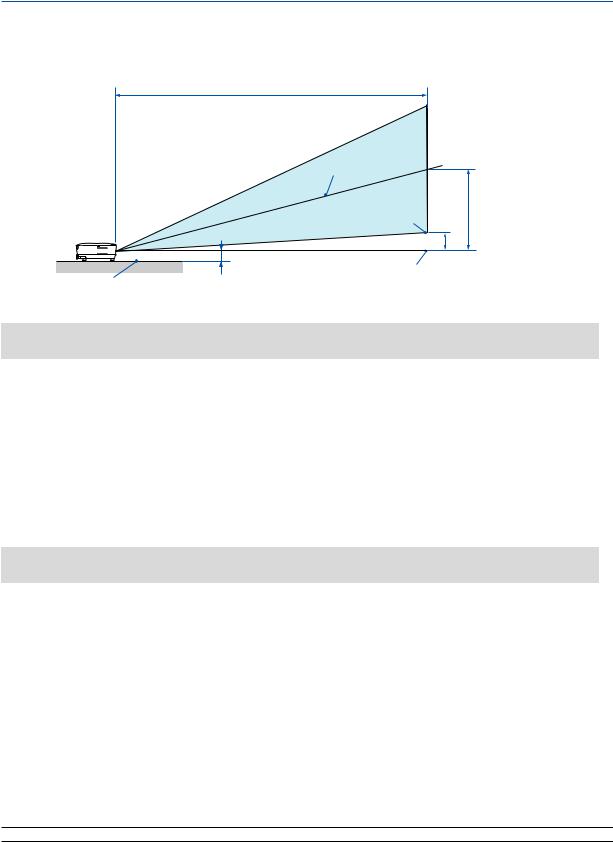
2. Installation and Connections
Throw Distance and Screen Size
The following shows the proper relative positions of the projector and screen. Refer to the table to determine the position of installation.
Distance Chart
C
Screen center
B
Screen bottom
D
2.7"/68 mm
Lens center
Installation surface
V300X/V260X/V230X/V260/V230
|
|
Screen Size |
|
|
B |
|
|
|
C |
|
|
|
D(WIDE) |
|
α |
|
|||
Diagonal |
Width |
Height |
|
Wide |
- |
Tele |
|
Wide |
- |
Tele |
|||||||||
|
|
|
|
|
|
||||||||||||||
inch |
mm |
inch |
mm |
inch |
mm |
inch |
|
mm |
inch |
mm |
- |
inch |
|
mm |
inch |
mm |
degree |
- |
degree |
30 |
762 |
24 |
610 |
18 |
457 |
12 |
|
297 |
46 |
1180 |
- |
52 |
|
1320 |
3 |
69 |
14.0 |
- |
12.7 |
40 |
1016 |
32 |
813 |
24 |
610 |
16 |
|
396 |
62 |
1573 |
- |
69 |
|
1760 |
4 |
91 |
14.0 |
- |
12.7 |
60 |
1524 |
48 |
1219 |
36 |
914 |
23 |
|
594 |
93 |
2360 |
- |
104 |
|
2640 |
5 |
137 |
14.0 |
- |
12.7 |
70 |
1778 |
56 |
1422 |
42 |
1067 |
27 |
|
693 |
108 |
2753 |
- |
121 |
|
3080 |
6 |
160 |
14.0 |
- |
12.7 |
80 |
2032 |
64 |
1626 |
48 |
1219 |
31 |
|
792 |
124 |
3147 |
- |
139 |
|
3520 |
7 |
183 |
14.0 |
- |
12.7 |
90 |
2286 |
72 |
1829 |
54 |
1372 |
35 |
|
891 |
139 |
3540 |
- |
156 |
|
3960 |
8 |
206 |
14.0 |
- |
12.7 |
100 |
2540 |
80 |
2032 |
60 |
1524 |
39 |
|
990 |
155 |
3933 |
- |
173 |
|
4400 |
9 |
228 |
14.0 |
- |
12.7 |
120 |
3048 |
96 |
2438 |
72 |
1829 |
47 |
|
1188 |
186 |
4720 |
- |
208 |
|
5280 |
11 |
274 |
14.0 |
- |
12.7 |
150 |
3810 |
120 |
3048 |
90 |
2286 |
58 |
|
1486 |
232 |
5900 |
- |
260 |
|
6600 |
13 |
343 |
14.0 |
- |
12.7 |
180 |
4572 |
144 |
3658 |
108 |
2743 |
70 |
|
1783 |
279 |
7080 |
- |
312 |
|
7920 |
16 |
411 |
14.0 |
- |
12.7 |
200 |
5080 |
160 |
4064 |
120 |
3048 |
78 |
|
1981 |
310 |
7867 |
- |
346 |
|
8800 |
18 |
457 |
14.0 |
- |
12.7 |
240 |
6096 |
192 |
4877 |
144 |
3658 |
94 |
|
2377 |
372 |
9440 |
- |
416 |
|
10560 |
22 |
548 |
14.0 |
- |
12.7 |
270 |
6858 |
216 |
5486 |
162 |
4115 |
105 |
|
2674 |
418 |
10620 |
- |
468 |
|
11880 |
24 |
617 |
14.0 |
- |
12.7 |
300 |
7620 |
240 |
6096 |
180 |
4572 |
117 |
|
2971 |
465 |
11800 |
- |
520 |
|
13200 |
27 |
685 |
14.0 |
- |
12.7 |
V300W/V260W
|
|
Screen Size |
|
|
B |
|
|
|
C |
|
|
|
D(WIDE) |
|
α |
|
|||
Diagonal |
Width |
Height |
|
Wide |
- |
Tele |
|
Wide |
- |
Tele |
|||||||||
|
|
|
|
|
|
||||||||||||||
inch |
mm |
inch |
mm |
inch |
mm |
inch |
|
mm |
inch |
mm |
- |
inch |
|
mm |
inch |
mm |
degree |
- |
degree |
30 |
762 |
25 |
646 |
16 |
404 |
10 |
|
252 |
39 |
1001 |
- |
43 |
|
1098 |
2 |
51 |
14.1 |
- |
12.9 |
40 |
1016 |
34 |
862 |
21 |
538 |
13 |
|
337 |
53 |
1335 |
- |
58 |
|
1464 |
3 |
67 |
14.1 |
- |
12.9 |
60 |
1524 |
51 |
1292 |
32 |
808 |
20 |
|
505 |
79 |
2002 |
- |
86 |
|
2196 |
4 |
101 |
14.1 |
- |
12.9 |
70 |
1778 |
59 |
1508 |
37 |
942 |
23 |
|
589 |
92 |
2336 |
- |
101 |
|
2562 |
5 |
118 |
14,1 |
- |
12.9 |
80 |
2032 |
68 |
1723 |
42 |
1077 |
27 |
|
673 |
105 |
2669 |
- |
115 |
|
2928 |
5 |
135 |
14.1 |
- |
12.9 |
90 |
2286 |
76 |
1939 |
48 |
1212 |
30 |
|
757 |
118 |
3003 |
- |
130 |
|
3294 |
6 |
152 |
14.1 |
- |
12.9 |
100 |
2540 |
85 |
2154 |
53 |
1346 |
33 |
|
841 |
131 |
3337 |
- |
144 |
|
3660 |
7 |
168 |
14.1 |
- |
12.9 |
120 |
3048 |
102 |
2585 |
64 |
1615 |
40 |
|
1010 |
158 |
4004 |
- |
173 |
|
4392 |
8 |
202 |
14.1 |
- |
12.9 |
150 |
3810 |
127 |
3231 |
79 |
2019 |
50 |
|
1262 |
197 |
5005 |
- |
216 |
|
5490 |
10 |
253 |
14.1 |
- |
12.9 |
180 |
4572 |
153 |
3877 |
95 |
2423 |
60 |
|
1515 |
236 |
6006 |
- |
259 |
|
6588 |
12 |
303 |
14.1 |
- |
12.9 |
200 |
5080 |
170 |
4308 |
106 |
2692 |
66 |
|
1683 |
263 |
6673 |
- |
288 |
|
7320 |
13 |
337 |
14.1 |
- |
12.9 |
240 |
6096 |
204 |
5169 |
127 |
3231 |
80 |
|
2019 |
315 |
8008 |
- |
346 |
|
8784 |
16 |
404 |
14.1 |
- |
12.9 |
270 |
6858 |
229 |
5816 |
143 |
3635 |
89 |
|
2272 |
355 |
9009 |
- |
389 |
|
9882 |
18 |
455 |
14.1 |
- |
12.9 |
300 |
7620 |
254 |
6462 |
159 |
4039 |
99 |
|
2524 |
394 |
10010 |
- |
432 |
|
10980 |
20 |
505 |
14.1 |
- |
12.9 |
B = Vertical distance between lens center and screen center C = Throw distance
D = Vertical distance between lens center and bottom of screen(top of screen for ceiling application) α = Throw angle
NOTE: The values in the tables are design values and may vary.
11

2. Installation and Connections
 WARNING
WARNING
*Installing your projector on the ceiling must be done by a qualified technician. Contact your NEC dealer for more information.
*Do not attempt to install the projector yourself.
•Only use your projector on a solid, level surface. If the projector falls to the ground, you can be injured and the projector severely damaged.
•Do not use the projector where temperatures vary greatly. The projector must be used at temperatures between 41˚F (5˚C) and 104˚F (40˚C). ([ECO MODE] is set automatically to [ON] at 95°F to 104°F/35°C to 40°C. Note that [ECO] mode will be set to [ON] automatically at 86°F to 104°F/30°C to 40°C when used in [HIGH ALTITUDE].)
•Do not expose the projector to moisture, dust, or smoke. This will harm the screen image.
•Ensure that you have adequate ventilation around your projector so heat can dissipate. Do not cover the vents on the side or the front of the projector.
Reflecting the Image
Using a mirror to reflect your projector's image enables you to enjoy a much larger image when a smaller space is required. Contact your NEC dealer if you need a mirror system. If you're using a mirror system and your image is inverted, use the MENU and buttons on your projector cabinet or your remote control to correct the orientation. (→ page 68)
12
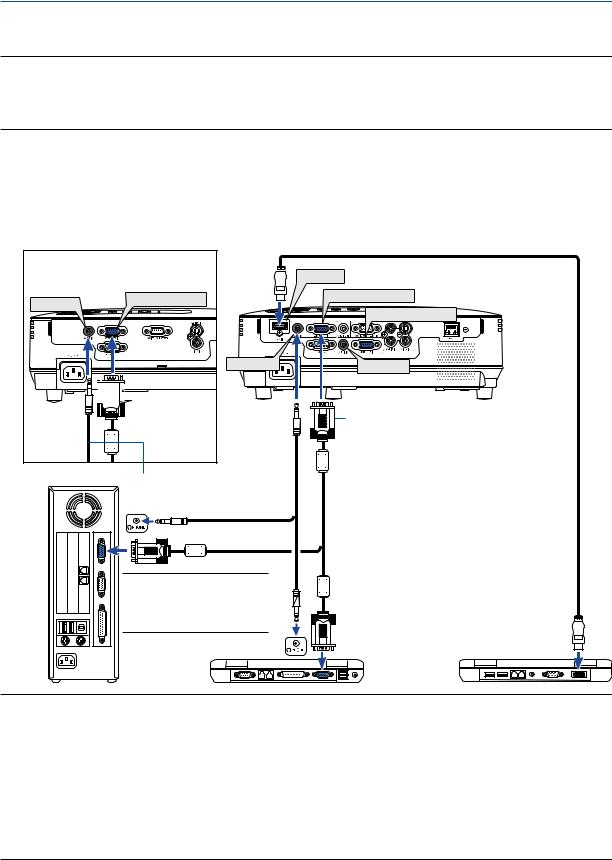
2. Installation and Connections
Making Connections
Connecting Your PC or Macintosh Computer
NOTE: When using with a notebook PC, be sure to connect the projector and notebook PC while the projector is in standby mode and before turning on the power to the notebook PC.
In most cases the output signal from the notebook PC is not turned on unless connected to the projector before being powered up.
*If the screen goes blank while using your remote control, it may be the result of the computer's screen-saver or power management software.
Enabling the computer’s external display
Displaying an image on the notebook PC’s screen does not necessarily mean it outputs a signal to the projector. When using a PC compatible laptop, a combination of function keys will enable/disable the external display. Usually, the combination of the ‘Fn” key along with one of the 12 function keys gets the external display to come on or off. For example, NEC laptops use Fn + F3, while Dell laptops use Fn + F8 key combinations to toggle through external display selections.
V230X/V260/V230
AUDIO IN |
COMPUTER IN |
|
AUDIO IN



 Computer
Computer
cable (VGA)
(supplied)
Stereo mini-plug audio cable (not supplied)
NOTE: For older Macintosh, use a commercially available pin adapter (not supplied) to connect to your Mac's video port.
HDMI IN |
V300X/V260X/V300W/V260W |
COMPUTER 1 IN |
|
|
COMPUTER 2 IN |
|
AUDIO IN |
|
Computer cable (VGA) |
|
(supplied) |
|
To mini D-Sub 15-pin connector on the |
|
projector. It is recommended that you use |
|
a commercially available distribution am- |
|
plifier if connecting a signal cable longer |
|
than the cable supplied. |
 Stereo mini-plug audio cable (not supplied)
Stereo mini-plug audio cable (not supplied)
HDMI cable (not supplied) 
Use High Speed HDMI®
Cable.
IBM VGA or Compatibles (Notebook type) or Macintosh (Notebook type)
NOTE:
•Before connecting an audio cable to the headphone jack of a computer, adjust the computer’s volume level to low. After connecting the projector to the computer, adjust the volume of both projector and computer to suitable level as desired to avoid damage to your ear.
•If an audio output jack of your computer is a mini jack type, connect the audio cable to it.
•An image may not be displayed correctly when a Video or S-Video source is played back via a commercially available scan converter. This is because the projector will process a video signal as a computer signal at the default setting. In that case, do the following.
-When an image is displayed with the lower and upper black portion of the screen or a dark image is not displayed correctly: Project an image to fill the screen and then press the AUTO ADJ. button on the remote control or the projector cabinet.
-V230X/V260/V230: The COMPUTER IN connector supports Plug & Play (DDC2B).
V300X/V260X/V300W/V260W: Both the COMPUTER 1 IN and COMPUTER 2 IN connectors support Plug & Play (DDC2B).
13
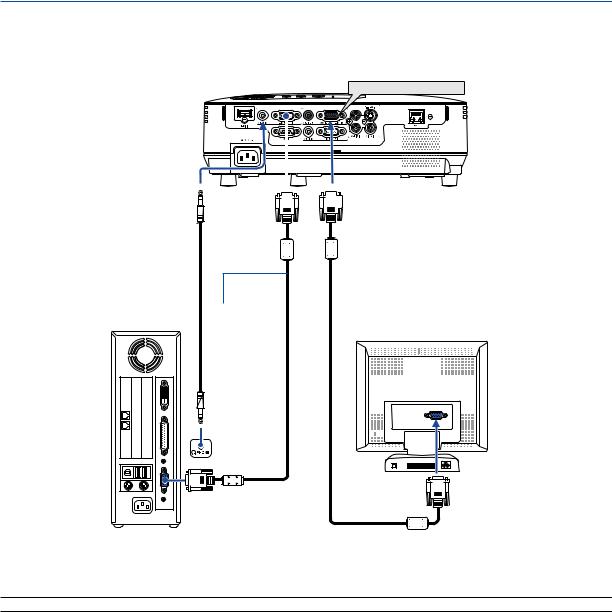
2. Installation and Connections
Connecting an External Monitor
V300X/V260X/V300W/V260W |
[V230X/V260/V230] |
||||||||||
|
|
|
|
|
|
|
|
MONITOR OUT (COMP 1) |
MONITOR OUT (COMP) |
||
|
|
|
|
|
|
|
|
|
|
|
|
|
|
|
|
|
|
|
|
|
|
|
|
|
|
|
|
|
|
|
|
|
|
|
|
|
|
|
|
|
|
|
|
|
|
|
|
|
|
|
|
|
|
|
|
|
|
|
|
 Computer cable (VGA) (supplied)
Computer cable (VGA) (supplied)
Computer cable (VGA)
(not supplied)
You can connect a separate, external monitor to your projector to simultaneously view on a monitor the computer analog image you’re projecting.
NOTE: Daisy chain connection is not possible.
14
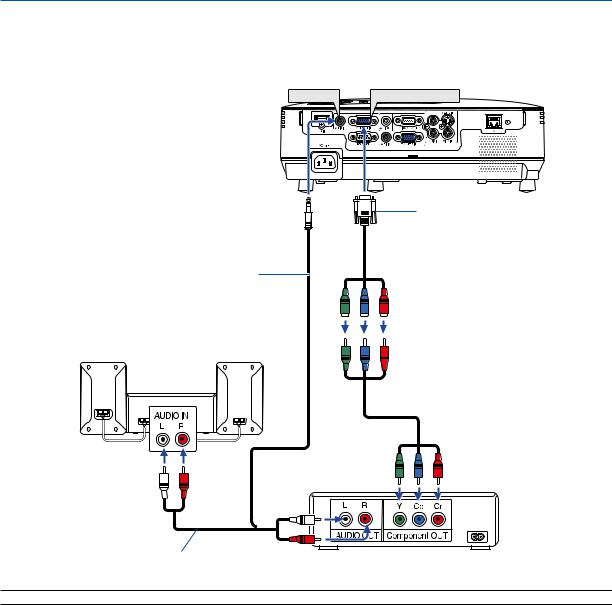
2. Installation and Connections
Connecting Your DVD Player with Component Output
Use audio equipment for stereo sound. The projector's built-in speaker is monaural.
V300X/V260X/V300W/V260W
AUDIO IN |
COMPUTER 1 IN |
[V230X/V260/V230] COMPUTER IN
Stereo mini plug - to - RCA audio cable (not supplied)
Audio Equipment
Audio cable (not supplied)
Optional 15-pin - to - RCA (female) ×3 cable (ADP-CV1E)

 Component video RCA×3
Component video RCA×3  cable (not supplied)
cable (not supplied)
DVD player
NOTE: Refer to your DVD player's owner's manual for more information about your DVD player's video output requirements.
15
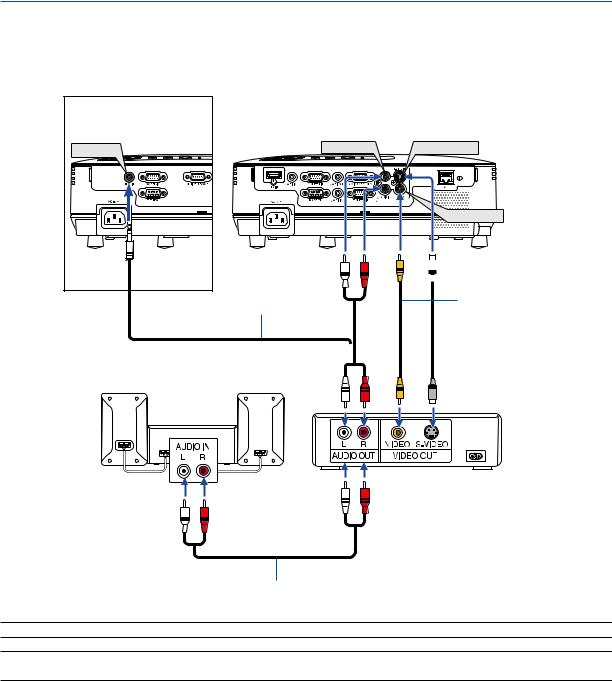
2. Installation and Connections
Connecting Your VCR
Use audio equipment for stereo sound.
The projector's built-in speaker is monaural.
V230X/V260/V230 |
AUDIO IN |
V300X/V260X/V300W/V260W
|
AUDIO IN |
S-VIDEO IN |
|||
|
|
|
|
|
|
|
|
|
|
|
|
|
|
|
|
|
|
|
|
|
|
|
|
Stereo mini plug - to
- RCA audio cable (not supplied)
VIDEO IN |
 S-Video cable (not supplied)
S-Video cable (not supplied)
Video cable (not supplied)
Audio equipment
VCR
Audio cable (not supplied)
NOTE: Refer to your VCR owner's manual for more information about your equipment's video output requirements.
NOTE: An image may not be displayed correctly when a Video or S-Video source is played back in fast-forward or fast-rewind via a scan converter.
V230X/V260/V230
TIP: The AUDIO IN Mini Jack (Stereo Mini) is shared between COMPUTER, VIDEO and S-VIDEO inputs.
16
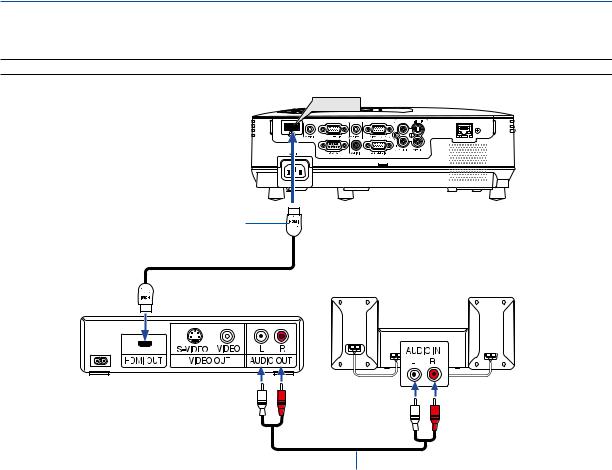
2. Installation and Connections
Connecting HDMI Input (V300X/V260X/V300W/V260W only)
You can connect the HDMI output of your DVD player, hard disk player, Blu-ray player, or notebook type PC to the HDMI IN connector of your projector.
NOTE: The HDMI IN connector supports Plug & Play (DDC2B).
HDMI IN
HDMI cable (not supplied)
Use High Speed HDMI®
Cable.
Audio cable (not supplied)
TIP: For users of audio video equipment with an HDMI connector:
Select “Enhanced” rather than “Normal” if HDMI output is switchable between “Enhanced” and “Normal”. This will provide improved image contrast and more detailed dark areas.
For more information on settings, refer to the instruction manual of the audio video equipment to be connected.
•When connecting the HDMI IN connector of the projector to the DVD player, the projector’s video level can be made settings in accordance with the DVD player’s video level. In the menu select [HDMI SETTINGS] → [VIDEO LEVEL] and make necessary settings.
•If the HDMI input sound cannot be heard, in the menu select [HDMI SETTINGS] → [AUDIO SELECT] → [HDMI] (→ page 71).
NOTE: HDMI signal
If the AC power supply is removed from the projector (Direct Power Off function) while displaying an image connected to the HDMI input, the projector may not display an image properly the next time it is powered up. Should this happen, power off the AC supply, power off your HDMI equipment (or disconnect the HDMI cable), and then power on the AC supply.
17
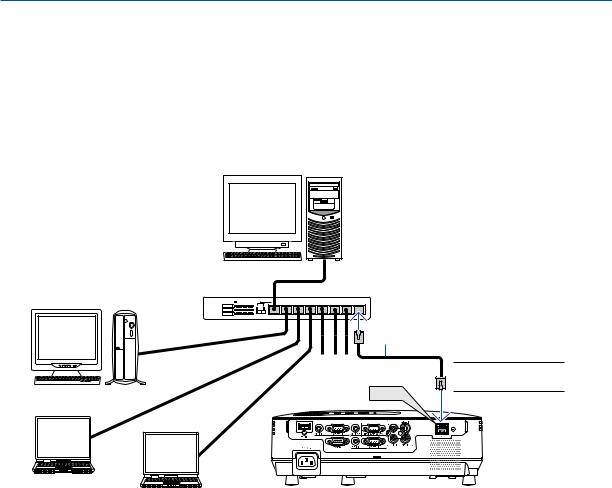
2. Installation and Connections
Connecting to a Network (V300X/V260X/V300W/V260W only)
The projector comes standard with a LAN port (RJ-45) which provides a LAN connection using a LAN cable.
Using a LAN cable allows you to specify the Network Settings and the Alert Mail Settings for the projector over a LAN. To use a LAN connection, you are required to assign an IP address to the projector on the [PROJECTOR NETWORK SETTINGS] screen of the web browser on your computer. For setting, see page 45, 46, 47.
Example of LAN connection
Example of wired LAN connection
Server
Hub
LAN cable (not supplied)
NOTE: Use a Category 5
or higher LAN cable.
LAN
18
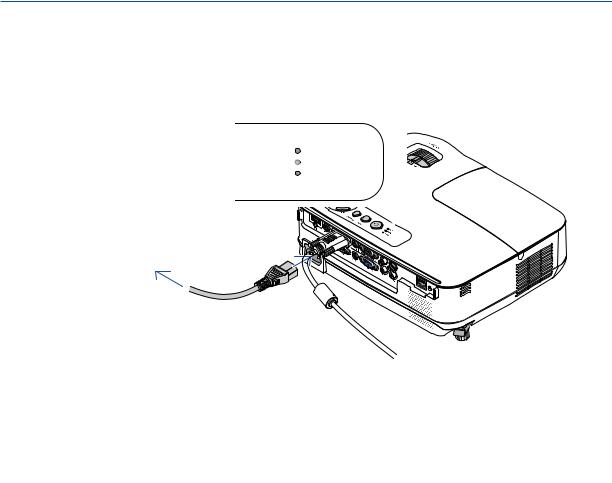
2. Installation and Connections
Connecting the Supplied Power Cord
Connect the supplied power cord to the projector.
First connect the supplied power cord's three-pin plug to the AC IN of the projector, and then connect the other plug of the supplied power cord in the wall outlet.
The projector will go into standby mode. When in standby mode, the POWER indicator will light orange and the STATUS indicator will light green when [NORMAL] is selected for [STANDBY MODE].
To wall outlet
Make sure that the prongs are fully inserted into both the power plug and the wall outlet.
 CAUTION:
CAUTION:
Parts of the projector may become temporarily heated if the projector is turned off with the POWER button or if the AC power supply is disconnected during normal projector operation.
Use caution when picking up the projector.
19
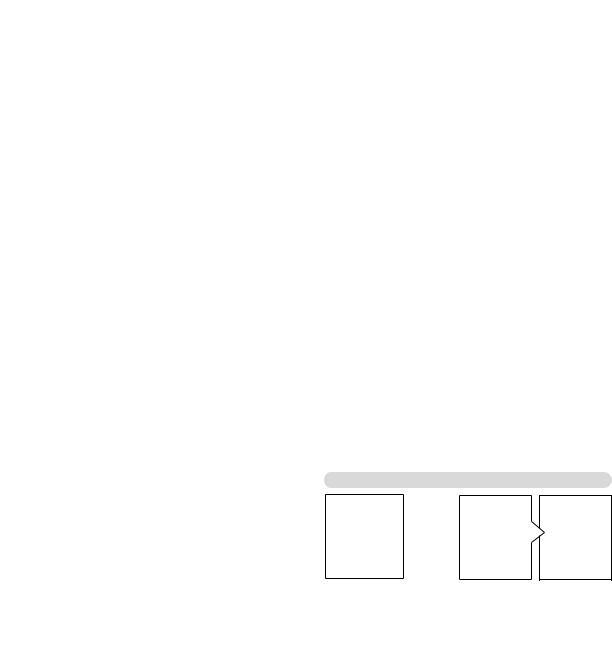
3. Projecting an Image (Basic Operation)
This section describes how to turn on the projector and to project a picture onto the screen.
Turning on the Projector
1.Remove the lens cap
• Do not remove the lens cap by pulling on the string. Doing so can cause mechanical damage to the part around the lens.
2.Press the  (POWER) button on the projector cabinet or the POWER ON button on the remote control.
(POWER) button on the projector cabinet or the POWER ON button on the remote control.
The POWER indicator will turn to green and the projector will become ready to use.
NOTE: When the projector is turned on, it may take some time before the lamp light becomes bright.
TIP:
•When the STATUS indicator lights orange, it means that the [CONTROL PANEL LOCK] is turned on. (→ page 68)
•When the message “Projector is locked! Enter your password.” is displayed, it means that the [SECURITY] is turned on. (→ page 34)
After you turn on your projector, ensure that the computer or video source is turned on and that your lens cap is removed.
NOTE: When no signal is available, the NEC logo (default), blue, or black screen will be displayed. After a lapse of 45 seconds from when the projector displays a blue, black or logo screen, [ECO MODE] will always switch to [ON]. This is done only when [ECO MODE] is set to [OFF].
Standby |
Preparing to power on Power On |
Steady orange light |
Blinking green light |
Steady green light |
(→ page 84)
20
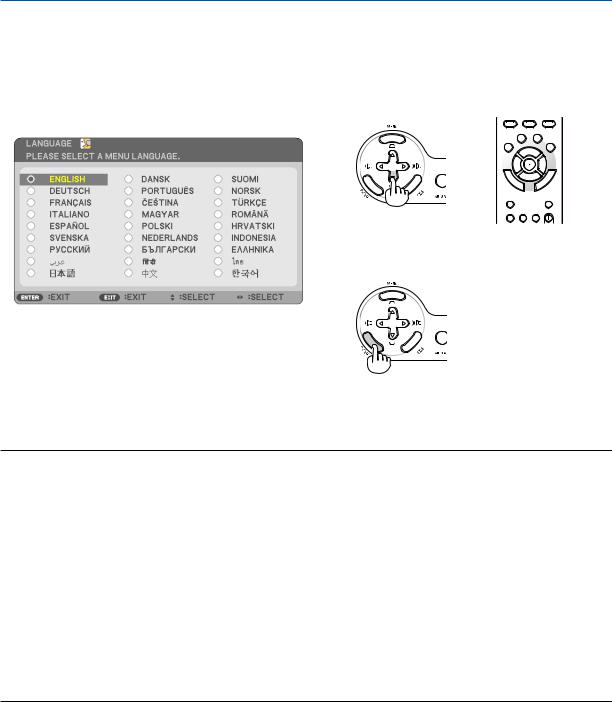
3. Projecting an Image (Basic Operation)
Note on Startup screen (Menu Language Select screen)
When you first turn on the projector, you will get the Startup menu. This menu gives you the opportunity to select one of the 27 menu languages.
To select a menu language, follow these steps:
1. Use the , , or button to select one of the 27 languages from the menu.
2. Press the ENTER button to execute the selection.
After this has been done, you can proceed to the menu operation.
If you want, you can select the menu language later. (→ [LANGUAGE] on page 54 and 65)
NOTE:
•If one of the following things happens, the projector will not turn on.
-If the internal temperature of the projector is too high, the projector detects abnormal high temperature. In this condition the projector will not turn on to protect the internal system. If this happens, wait for the projector's internal components to cool down.
-When the lamp reaches its end of usable life, the projector will not turn on. If this happens, replace the lamp.
-If the STATUS indicator lights orange as long as the POWER button is pressed, it means the CONTROL PANEL LOCK has been set.
-If the lamp fails to light, and if the STATUS indicator flashes on and off in a cycle of six times, wait a full minute and then turn on the power.
•The projector cannot be turned off with the ON/STAND BY button or the POWER OFF button while the POWER indicator is flashing green in a cycle of 0.5 second on and 0.5 second off.
•Do not disconnect the AC power supply to the projector for 60 seconds immediately after turning it on and displaying an image.
•Immediately after turning on the projector, screen flicker may occur. This is normal. Wait 3 to 5 minutes until the lamp lighting is stabilized.
•If you turn on the projector immediately after the lamp is turned off or when the temperature is high, the fans run without displaying an image for some time and then the projector will display the image.
21
